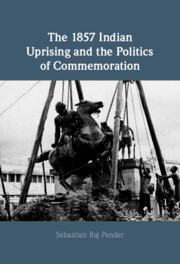Refine search
Actions for selected content:
21 results
10 - A Southern Ambiance
-
- Book:
- A Black Army
- Published online:
- 16 June 2025
- Print publication:
- 17 July 2025, pp 186-207
-
- Chapter
- Export citation
9 - The First Departure
-
- Book:
- A Black Army
- Published online:
- 16 June 2025
- Print publication:
- 17 July 2025, pp 169-185
-
- Chapter
- Export citation
12 - Ready for Combat
-
- Book:
- A Black Army
- Published online:
- 16 June 2025
- Print publication:
- 17 July 2025, pp 232-251
-
- Chapter
- Export citation
4 - Protestors
-
- Book:
- Making Do
- Published online:
- 24 April 2025
- Print publication:
- 24 April 2025, pp 132-164
-
- Chapter
- Export citation
8 - Making It in This Thing
- from Scene II - Hieronymus Sebastian Schutze, Felix Steter, and Wolfgang Winkelmann
-
- Book:
- The War People
- Published online:
- 19 December 2024
- Print publication:
- 19 December 2024, pp 146-163
-
- Chapter
- Export citation
Chapter 5 - The Military Labour Market
-
- Book:
- Soldiers, Wages, and the Hellenistic Economies
- Published online:
- 21 May 2024
- Print publication:
- 09 May 2024, pp 143-166
-
- Chapter
- Export citation
2 - Life in the Army of the Continent
- from Part I - Early Manifestations
-
- Book:
- Born in Blood
- Published online:
- 18 January 2024
- Print publication:
- 18 January 2024, pp 50-72
-
- Chapter
- Export citation
12 - Changes and Challenges at Alexander’s Court
- from Part II - Contexts
-
-
- Book:
- The Cambridge Companion to Alexander the Great
- Published online:
- 04 January 2024
- Print publication:
- 18 January 2024, pp 192-212
-
- Chapter
- Export citation
1 - The Making of a Cold War City in Eastern Africa
-
- Book:
- Revolutionary State-Making in Dar es Salaam
- Published online:
- 13 October 2022
- Print publication:
- 22 December 2022, pp 26-65
-
- Chapter
-
- You have access
- Open access
- HTML
- Export citation
5 - The Empire Preserved
-
- Book:
- The Company's Sword
- Published online:
- 08 September 2022
- Print publication:
- 25 August 2022, pp 142-170
-
- Chapter
- Export citation

The 1857 Indian Uprising and the Politics of Commemoration
-
- Published online:
- 21 April 2022
- Print publication:
- 05 May 2022
6 - Insurgency, Politics, and Religion
- from Part I
-
- Book:
- Convicts
- Published online:
- 06 January 2022
- Print publication:
- 13 January 2022, pp 172-216
-
- Chapter
- Export citation
1 - The Making of a Cold War City in Eastern Africa
-
- Book:
- Revolutionary State-Making in Dar es Salaam
- Published online:
- 07 September 2021
- Print publication:
- 16 September 2021, pp 26-65
-
- Chapter
- Export citation
2 - The Indian Rebellion, 1857–1858
-
-
- Book:
- Queen Victoria's Wars
- Published online:
- 01 June 2021
- Print publication:
- 17 June 2021, pp 8-39
-
- Chapter
- Export citation
Chapter 4 - Authority and Allegiances
-
- Book:
- Warfare in the Roman World
- Published online:
- 04 September 2020
- Print publication:
- 17 September 2020, pp 89-112
-
- Chapter
- Export citation
Confronting Rebellion in Weak States: Government Response to Military Mutiny in Benin
-
- Journal:
- African Studies Review / Volume 64 / Issue 2 / June 2021
- Published online by Cambridge University Press:
- 03 September 2020, pp. 363-389
-
- Article
- Export citation
Preface
-
- Book:
- The Genesis of Rebellion
- Published online:
- 17 June 2020
- Print publication:
- 03 September 2020, pp xv-xvi
-
- Chapter
- Export citation
3 - The Use and Abuse of the Black Soldier
-
- Book:
- Military Medicine and the Making of Race
- Published online:
- 13 March 2020
- Print publication:
- 02 April 2020, pp 84-112
-
- Chapter
- Export citation
3 - Violence, Non-Violence, the State and the Nation: India, 1858–1958
- from Part I - Race, Religion and Nationalism
-
-
- Book:
- The Cambridge World History of Violence
- Published online:
- 13 March 2020
- Print publication:
- 26 March 2020, pp 68-87
-
- Chapter
- Export citation
15 - Agrarian society
- from Part III - The sinews of war
-
-
- Book:
- The Cambridge History of the First World War
- Published online:
- 05 December 2013
- Print publication:
- 09 January 2014, pp 382-407
-
- Chapter
- Export citation
